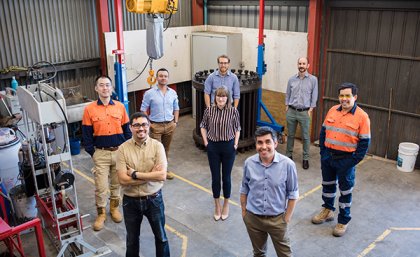
It’s not easy to predict how rock will fracture when exposed to a blast hundreds of metres below the earth’s surface, but a piece of experimental equipment will take away the guess work for The University of Queensland’s blasting and fragmentation technology team.
The unique chamber will allow the team, led by UQ’s Associate Professor Italo Onederra and Dr Christopher Leonardi, to validate advanced modelling tools that will help them to develop safer mining techniques that are also better for the environment.
Dr Onederra said the team was the only research group in the world with this kind of experimental capability.
“We can place a rock in the enclosed chamber, apply hydrostatic pressure, then set off a blast to simulate a deep underground rock blasting scenario,” Dr Onederra said.
“It allows us to see how rocks react under these very specific conditions, filling knowledge gaps in the fundamental science of rock fragmentation, which will ultimately improve outcomes on mine sites and beyond.
“We are able to combine this new capability with our rock characterisation process that uses specialised digital imaging techniques and advanced numerical algorithms for blasting and fluid flow modelling, positioning us perfectly to tackle some of the big challenges facing the mining sector as it transitions to net zero emissions,” he said.
Resource industry giant BHP – the company funding the work – conducted an international search for a team with the necessary skills and research capabilities to carry out this program of applied research.
UQ, along with SRI International (USA) and Imperial College London, was selected as a leader in its field.
To support the research, SRI International donated the purpose-built experimental chamber to the team at UQ.
“We are focussing on future underground mining techniques that aim to eliminate waste rock and tailing dams, significantly reducing the environmental footprint of the industry,” Dr Onederra said.
“There are many challenges ahead as mining will take place in deeper and more complex geotechnical environments, making it more difficult, dangerous and expensive to extract the minerals and materials we all rely on every day.
“Our capabilities give us the freedom to think outside the box and study a number of areas involving the use of explosives to extract minerals in a more energy efficient and sustainable way.
“We are probably the only group in the world embarking on such different research, including unconventional excavation and crushing systems using energetic materials.
“We think that it is possible to transition out of current energy intensive systems used in industry that fundamentally date back to inventions from the 19th century.
“With these exciting opportunities forming, we know the future of mining is already here.”
The blasting and fragmentation technology team is a diverse and multidisciplinary team of researchers and support staff with expertise in geology, hydrometallurgy, geotechnical engineering, detonation physics, blast engineering technology and advanced computational modelling.
The team is part of the newly established research Centre for Future Autonomous Systems and Technologies (FAST) at the UQ School of Mechanical and Mining Engineering, led by Associate Professor Onederra.
Dr Christopher Leonardi brings computational flow modelling and analysis expertise from the Centre for Energy Futures at the School of Mechanical and Mining Engineering.
Media: UQ communications, communications@UQ.edu.au; +61 7 3365 3439.
.jpg)












